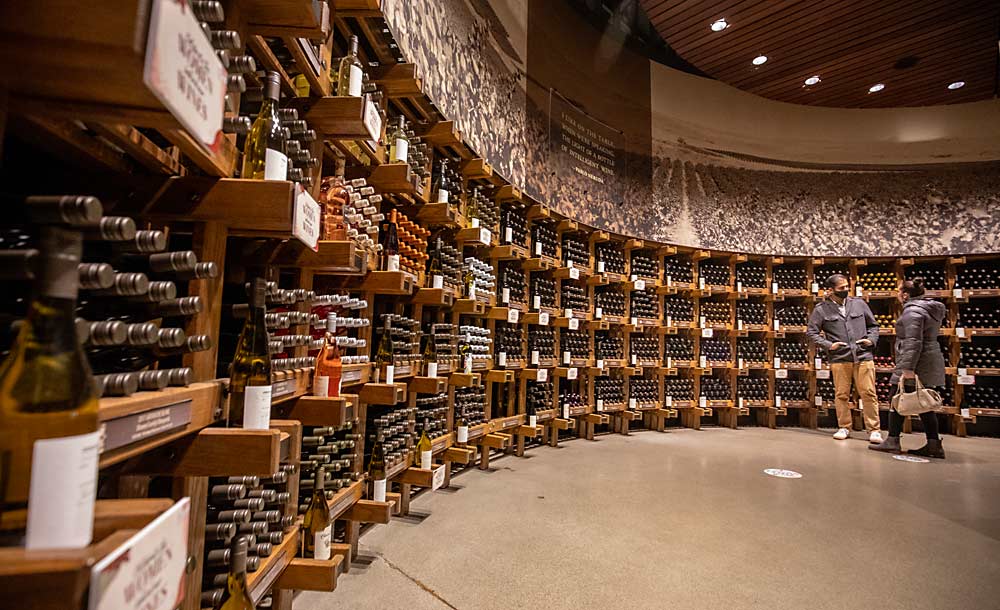
Washington’s wine industry will need to shed about 15 percent of its grape acreage to adjust to Ste. Michelle Wine Estates’ decision to scale back production.
The change will be painful, industry experts said.
“I know it’s devastating,” said Shane Collins, winemaker at Fielding Hills Winery in Chelan and board chair of the Washington Winegrowers Association. “People are likely going to go out of business.”
The organization representing the state’s growers recommends strategically removing about 10,000 acres after the Northwest’s largest winery informed growers of plans to reduce its crush by 40 percent in the coming years, to align with declining alcohol consumption and a persistent oversupply. Overall, the state has about 61,000 acres.
“Unless the wine category rebounds magically, reducing the inventory backlog of wine and bulk wine, our acreage needs a reduction of about 10,000 acres,” said Vicky Scharlau, executive director of the Washington Winegrowers Association.
Several growers told Good Fruit Grower the 40 percent estimate, which includes existing contracts. They asked to remain anonymous because they are negotiating individually with the company.
Ste. Michelle declined to confirm figures.
“These measures are about bringing our business into a sustainable balance and enabling us to focus on making the highest quality wines possible,” said Lynda Eller, director of communications for Ste. Michelle, in a written statement. “By working with our grower partners, as challenging as this process is, we are ultimately committing to the long-term health and vitality of both our business and Washington wine.”
The company also closed the crush pad at its 14 Hands Winery in Prosser, shifting grapes to its biggest facility, Columbia Crest in nearby Paterson, Eller said. The 14 Hands tasting room remains open, and no employees there were laid off.
Ste. Michelle is the one of the largest wine companies in the country, with properties and facilities throughout the West and several well-known brands, including Columbia Crest, Red Diamond and Erath.
In Washington, the industry has relied on Ste. Michelle as a vital driver since its earliest days. The companies that would eventually comprise Ste. Michelle were founded at the end of Prohibition and first planted classic Vitis vinifera varieties in the arid Columbia Basin in the 1950s. Eventually, the company’s efforts turned the state into the country’s second-largest producer, behind California. The company routinely crushed 60 percent or more of the state’s grapes.
Small, boutique wineries flourished in Washington in the wake of Ste. Michelle. Today, about 90 percent of the state’s 1,000-plus wineries produce 5,000 or fewer cases annually, according to the Washington State Wine Commission.
In 2021, Ste. Michelle was purchased for $1.2 billion by Sycamore Partners, a New York private equity firm with $10 billion in aggregate committed capital, encompassing a diverse array of brands and stores, such as office supply vendor Staples and clothing company Lane Bryant. In 2021, it purchased three cruise ships and associated intellectual property from Royal Caribbean for $201 million in cash. It also was one of the suitors seeking to purchase the Subway food chain before Roark Capital secured the deal for $9.6 billion in late August.
After the Sycamore purchase, Ste. Michelle announced changes to its leadership and winemaking teams. In 2022, it purchased A to Z Wineworks, a top-selling Oregon winery. This year, the company announced a 5 percent workforce reduction and hired Shawn Conway as CEO, former chief executive of Peet’s Coffee. Months later, it sold off its share of Stag’s Leap Wine Cellars, a large winery in California’s Napa Valley, to focus on the Northwest, though the company has kept some California properties.
Tough times
Cutting active contracts is unusual in the Washington wine industry, said Collins, whose company does not sell grapes to Ste. Michelle.
Collins and Scharlau don’t blame Ste. Michelle. The industry at large has been oversupplied for many years, something growers concede.
“Ste. Michelle is a good industry partner,” Collins said. “They’re just going through tough times.”
Ste. Michelle sponsors many industry programs, fundraisers and field days, and it contributed the final $500,000 for the Washington State University Wine Science Center in Richland, built in 2015 for $23 million with a combination of industry contributions, private donations and federal and state money. Then-CEO Ted Baseler led the fundraising effort. The university named the building after the company.
Led by Ste. Michelle, Washington’s wine industry surged starting in the 1990s, often outpacing the rest of the United States, said Chris Bitter, a California-based wine and grape analyst for Terrain, a team of economists that shares market insight with customers of American AgCredit and other farm credit system partners.

However, about 10 years ago, wine consumption throughout the country started to plateau in the face of changing market demographics and competition from craft beer, cider and hard seltzers. Sales of lower-priced wines began to decline. Eventually, the high-priced luxury bottles couldn’t continue to make up the difference.
“This problem has been brewing for a really long time,” Bitter said.
State shipments peaked in 2016, when Ste. Michelle accounted for two-thirds of the state’s roughly 12.9 million cases. Plantings slowed, but vines already in the ground continued to come into production. The ship couldn’t turn quickly enough. In 2021, the most recent year for complete data, Ste. Michelle shipped 6.7 million cases out of Washington’s 12 million overall.
In 2020, Bitter, who then owned his own Washington-specific research company called Vintage Economics, told growers the state would need to either significantly boost shipments or cut 8,500 acres.
The pandemic postponed and complicated the problem. Wine sales shot up as shoppers, flush with stimulus cash, loaded up on cases to ride out lockdowns with a buzz. Inevitably, that started to subside — and still is subsiding. The national industry does not know where the new floor is, Bitter said.
The effects of Ste. Michelle’s changes will spill over state borders by driving down prices as more grapes hit the overall market, said James Sterns, an ag economist at Oregon State University and a member of the Oregon Wine Research Institute.
In 2021, Oregon shipped 26 percent — about 30,000 tons — of its grapes out of state, according to the Oregon Wine Board. That doesn’t necessarily mean they all went to Ste. Michelle, or even Washington, but even a fraction of that would disrupt the market, Sterns said.
“Now with a smaller, less dominant Ste. Michelle, the Washington wine industry will more closely resemble the Oregon wine industry,” Sterns said. “This could bode well for more collaborative efforts around shared interests, particularly in terms of addressing shifting consumer markets.”
Bitter expressed hope for Washington’s future profitability after this rough patch. The state still has a “strong quality-to-price ratio,” he said.
Scharlau agreed.
“We’re known for our creativity,” she said. “Plus, standing on the shoulders of our founders, the next generation of Washington vintners are an incredibly impressive lot.”
—by Ross Courtney
Editor’s note: An earlier version of this story ranked Ste. Michelle Wine Estates in comparison to other U.S. wineries with outdated numbers from another source Good Fruit Grower did not independently confirm. Wine Business Monthly, which tracks production, put Ste. Michelle — with 7 million cases — in eighth place on its February 2023 list. Also,Terrain shares insight with customers of American AgCredit and other farm credit system partners. The original story misidentified those partners as the system’s regulatory agency, the Farm Credit Administration. We regret the errors.








Better check you facts nd figures, SMWE is no way the “third largest wine company in the US– Never was. I worked for the company in the late 1t decade of this century. Not even sure they are still in top 10
“Thanks for catching that Joel. After some of our own research we agree that you have a good point, though clear rankings are hard to track. We’ve updated the wording of our online stories.”